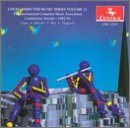| All Artists: Cdcm Computer Music Series Title: CDCM Computer Music Series Vol 21 - ICMA Commission Awards 1992-3 Members Wishing: 1 Total Copies: 0 Label: Centaur Release Date: 3/26/1996 Genre: Classical Styles: Chamber Music, Historical Periods, Modern, 20th, & 21st Century, Instruments, Electronic Number of Discs: 1 SwapaCD Credits: 1 UPC: 789368328222 |
Search - Cdcm Computer Music Series :: CDCM Computer Music Series Vol 21 - ICMA Commission Awards 1992-3
 | Cdcm Computer Music Series CDCM Computer Music Series Vol 21 - ICMA Commission Awards 1992-3 Genre: Classical
|
Larger Image |
CD Details |
CD ReviewsFour interesting computer-music commissions Steve Benner | Lancaster, UK | 03/10/2001 (4 out of 5 stars) "The International Computer Music Association (ICMA) describes itself as "an international affiliation of individuals and institutions involved in the technical, creative, and performance aspects of music." It regards itself (and its annual International Computer Music Conference, ICMC) as the principal meeting ground for composers, computer software and hardware developers, researchers and musicians and anyone else interested in the integration of music and technology. Since 1992, the ICMA has made a number of annual Commission Awards, resulting in new works from leading composers in the field of computer music, for performance at the Association's annual gathering.This disc presents the works commissioned for performance at the 1992 ICMC at San Jose State University, CA, USA, and at the 1993 ICMC, held at Waseda University, Tokyo, Japan.It opens with "KITAB" (1992) by the Argentinean composer, Horacio Vaggione, scored for bass clarinet, piano, and double bass, plus a collection of separate electroacoustic sequences realised by computer means. In this 14-minute work, the electroacoustic treatments are triggered by means of MIDI converters, with the acoustic instruments amplified, in order to maintain a balance between the sources. The electroacoustic elements themselves are derived from sampled sounds produced by the three acoustic instruments involved in the piece. Even though they have been subjected to computer alteration and manipulation, they nevertheless maintain sufficient of their original character to come across more as extensions to those instruments, than as another voice altogether. The amplification of the acoustic instruments also permits the complete integration of treated and untreated elements of the piece and results in a cohesion and unity of sound across the entire canvas of the piece that is rare in works for live performer and tape. Vaggione's density of scoring results in both texture and gesture becoming combined into a powerful, and excitingly dynamic sound world, which communicates more on a visceral level than an intellectual one. It is easy to see why this senior figure in the world of computer music has been honoured with so many awards over the years. The companion piece to "KITAB" at the 1992 ICMC was "Three Inventions" by Japanese composer, Takayuki Rai. The three 5-minute (or less) movements of this work, scored for soprano saxophone, double bass, piano, harp, and live computer electronic system (comprising a NeXT computer and IRCAM Signal Processing Workstation, ISPW) are more introspective than the previous work. Indeed, Rai demonstrates the same deftness of touch as fellow Japanese composer Toru Takemitsu in this composition but with the electronic component providing just a little extra bite, from time to time. The processed sounds provided by the ISPW act sometimes as extensions to the live instruments and at other times as a fifth voice within the ensemble. American composer Cort Lippe provides a similar role for the ISPW in his 1993 work, "Music for Sextet and ISPW". This is a more intense piece than the Rai, scored for somewhat heavier forces of flute, bass clarinet, trombone, violin, 'cello, and piano, together with the ISPW, which provides a cross-synthesis of the live instruments, in addition to standard signal processing, such as pitch shifting and spatialisation effects. The result is a continuous interplay between the voices of the sextet and the electronic component, at times separate, at other times fused, often with a wonderfully shifting ambiguity, as to which is which.The final work on the disc is Ira Mowitz's 12-minute piece "Kol Aharon (The Voice of Aaron)", for violin and computer-generated tape. Most listeners will probably regard the work as being for violin and burbling baby, for the tape which accompanies the violin soloist consists mostly of computer processed samples of the voice of the composer's 18-month old son, Aaron. (Although the composer tells us that the work's title refers to the story from the Old Testament book of Exodus, in which Aaron acted as the mouthpiece for his brother Moses in delivering the words of God to Pharaoh!) The violin part has a lyricism and virtuosity that is all too uncommon in contemporary western art music, although I have to say, I found it rather at odds with the tape component for much of the work's duration. Whilst the tape part may irritate just a little from time to time, the work is certainly not unpleasant, just a little disconcerting. But then, perhaps the words of God are not intended to be comfortable?As with most CDCM releases, the music presented on this CD is something of a mixed bag. It is all well worth hearing, though, especially for anyone the slightest bit interested in following the cutting edge of the American avant-garde, and the disc can be wholeheartedly recommended."
|

 Track Listings (6) - Disc #1
Track Listings (6) - Disc #1